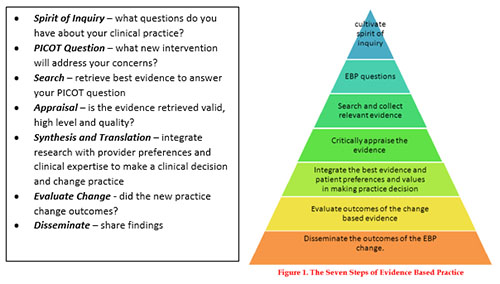Online Course
NRSG 790 - Methods for Research and Evidence-Based Practice
Module 1: Introduction to Evidence-Based Practice
EBP Framework

The primary purpose of evidence based practice is to improve patient outcomes. This is addressed through clinical practice improvements as well as organizational and educational changes that impact care delivery. Consider the example below of a problem regarding transition to practice for new graduate nurses. Exploring this practice problem requires that we first research the background, the current practice, and alternatives that may lead to improvements.
Begin thinking about a practice problem of interest to you and start researching the background – what is the problem with our current practice? What alternative approach have you read about that would improve the outcomes of concern.
Problem
Higher turnover rate and job dissatisfaction among newly licensed nurses
Background
Transition-to-practice is a vulnerable time for nurses, their patients, and organizations they work for, marked by a 17.5% employment attrition rate in the nurse’s first year of practice, and nearly doubling to 33% in the second year (Kovner, Brewer, Fatehi, & Junn, 2014). Behind these numbers are stressed and dissatisfied new nurses who often lack the competencies needed to provide 21st century healthcare. Ninety percent of nurse executives regard new nurses as less than competent on entry into practice (Berkow, Virkstis, Stewart, & Conway, 2018). The state of under-preparedness among new nurses is attributed to the complexity of the current health care environment and significant role demands, and is compounded by the rapid deployment of new nurses into practice after graduation since the introduction of computerized testing for nursing licensure in 1994.
Current Standard Practice
Newly licensed nurses are most typically onboarded through a new employee orientation to the facility, and preceptor programs of variable length and curriculum.
EBP Alternative
Post-graduate education for nurses through residency programs has emerged over the past two decades as a promising transition initiative to address the unique professional development needs of the new nurse. Evidence indicates that participation in a nurse residency program results in lower first year nurse attrition rates, providing organizations with a significant return on investment associated with reduced replacement and labor costs. Nurse residency programs are also associated with increases in clinical competency, confidence, and work satisfaction, with a reduction in errors rates and negative safety patient events (Edwards, Hawker, Carrier, & Ress, 2015; Goode, Lynn, & McElroy, 2013; Letourneau & Fater, 2015; Spector et al., 2015).
This website is maintained by the University of Maryland School of Nursing (UMSON) Office of Learning Technologies. The UMSON logo and all other contents of this website are the sole property of UMSON and may not be used for any purpose without prior written consent. Links to other websites do not constitute or imply an endorsement of those sites, their content, or their products and services. Please send comments, corrections, and link improvements to nrsonline@umaryland.edu.